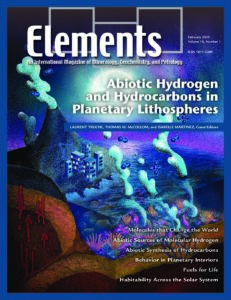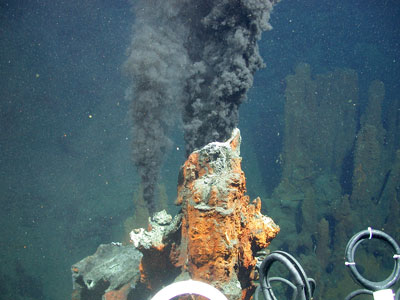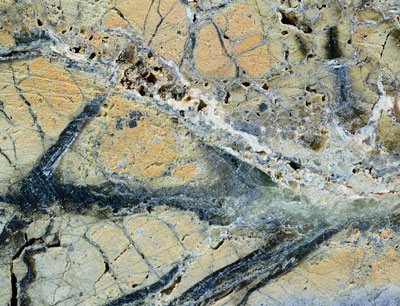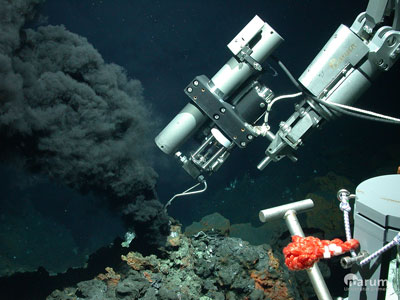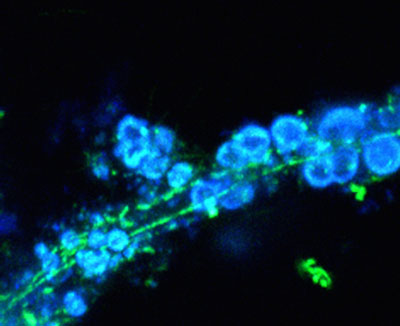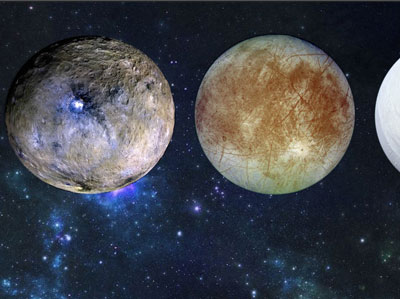Abiotic Hydrogen and Hydrocarbons in Planetary Lithospheres
Laurent Truche, Thomas M. McCollom, and Isabelle Martinez – Guest Editors
Table of Contents
Abiotic molecular hydrogen and hydrocarbons have been observed in a variety of geologic settings both on Earth and other planetary bodies. Owing in large part to the utilization of hydrogen and methane by chemosynthetic biological communities, the geologic production of these compounds has become the subject of intense scientific study. Geologically produced hydrogen and methane are also of interest as possible energy resources. This issue highlights recent developments in the understanding of geologic sources of hydrogen and methane, the biological utilization of these compounds, and the potential for human exploitation of these resources.
- Hydrogen and Abiotic Hydrocarbons: Molecules that Change the World
- Abiotic Sources of Molecular Hydrogen on Earth
- Abiotic Synthesis of Methane and Organic Compounds in Earth’s Lithosphere
- The Behavior of H2 in Aqueous Fluids under High Temperature and Pressure
- Abiotic Hydrogen and Methane: Fuels for Life
- Hydrogen, Hydrocarbons, and Habitability Across the Solar System
Crystal Maker
Excalibur Mineral Corporation
Gemological Institute of America
Ionplus AG
ProtoXRD
Savillex
University of Wisconsin-Madison
v16n2 Raman Spectroscopy in the Earth and Planetary Sciences
GUEST EDITORS: Jill D. Pasteris (Washington University in Saint Louis, USA) and Olivier Beyssac (CNRS-Sorbonne University Paris, France)
The application of Raman (microprobe) spectroscopy in the geosciences has rapidly broadened and deepened over the past 40 years. This has been sparked by both improvements in technology and recognition of the quantitative, as well as qualitative, capabilities of the technique. Raman spectroscopy claims relative ease of use; is typically nondestructive at the (sub-)micrometer scale; has the ability to analyze solids, liquids, and gases; can differentiate polymorphs; and can enlarge the available spectral databases for minerals. Geoscientists can create Raman maps/images based on selected spectral features, which simultaneously capture chemical–structural and microtextural information. In a single sample, one may investigate quantitatively the P–T path history during metamorphism, determine the composition and internal pressure of mixed volatiles in micrometer-size fluid inclusions, study the strain pattern or radiation damage in minerals, and/or target possible biosignatures.
- Welcome to Raman Spectroscopy: Successes, Challenges, and Pitfalls Jill D. Pasteris (Washington University in Saint Louis, USA) and Olivier Beyssac (CNRS-Sorbonne University Paris, France)
- Microscale Chemistry: Raman Analysis of Fluid and Melt Inclusions Robert J. Bodnar (Virginia Tech, USA) and Maria Luce Frezzotti (University of Milan–Bicocca, Italy)
- Applications of Raman Spectroscopy in Mineralogy and Geochemistry Lutz Nasdala (University of Vienna, Austria) and Christian Schmidt (GFZ German Research Centre for Geosciences, Potsdam, Germany)
- Applications of Raman Spectroscopy in Metamorphic Petrology and Tectonics Andrey V. Korsakov (Sobolev Institute of Geology and
Mineralogy, Russia), Matthew J. Kohn (Boise State University, USA) and Maria Perraki (Technical University of Athens, Greece) - Geoscience Meets Biology: Raman Spectroscopy in Geobiology and Biomineralization Andrew Steele (Carnegie Institution of Washington, USA), Marc D. Fries (NASA Johnson Space Center, USA) and Jill D. Pasteris (Washington University in Saint Louis, USA)
- New Trends in Raman Spectroscopy: From High-Resolution Geochemistry to Planetary Exploration Olivier Beyssac (CNRSSorbonne University Paris, France)
- Abiotic Hydrogen and Hydrocarbons in Planetary Lithospheres (February 2020)
- Raman Spectroscopy in the Earth and Planetary Sciences (April 2020)
- The Redox Engine of Earth (June 2020)
- Lithium: Less is More (August 2020)
- Noble Gas Thermochronology (October 2020)
- Hydrothermal Fluids (December 2020)



